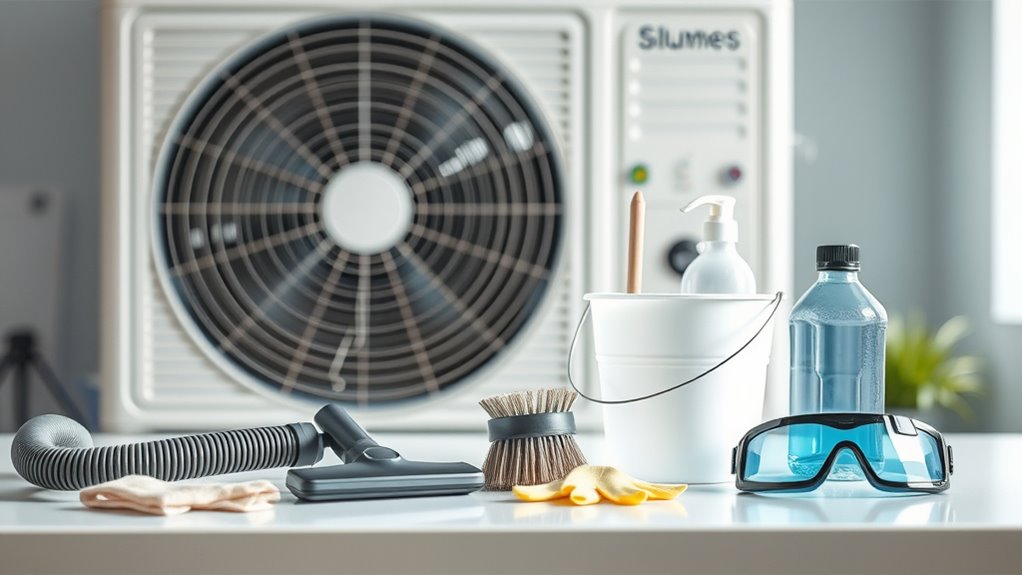How to Unclog an AC Drain Pipe: Step-by-Step Cleaning Guide
Introduction

AC drain pipes are prone to clogs due to the accumulation of debris, dirt, and algae.
Ignoring a clogged drain can lead to water damage, mold growth, and reduced efficiency of the air conditioning system.
Understanding the causes and potential risks associated with these clogs is essential for maintaining a healthy and functional AC unit.
Why AC Drain Pipes Get Clogged
When humidity levels rise, condensation forms within the air conditioning system, leading to the accumulation of water in the drain pipe. Over time, this excess moisture can create an ideal environment for mold and algae growth, contributing to clogs. Additionally, dirt, dust, and debris can be drawn into the system, further obstructing the flow of water. Insects and small debris may also find their way into the drain, compounding the blockage issue. Understanding these factors can help homeowners maintain their AC systems effectively.
| Cause of Clog | Description | Prevention Method |
|---|---|---|
| Humidity | Excess moisture accumulation | Use a dehumidifier |
| Mold and Algae | Growth in stagnant water | Regular cleaning |
| Dirt and Dust | Contamination from the environment | Change filters regularly |
| Insect Infestation | Entry through openings | Seal gaps around the unit |
| Debris | Leaves and small objects | Install drain covers |
Risks of Ignoring a Clogged Drain Pipe
Ignoring a clogged drain pipe can lead to significant problems that extend beyond mere inconvenience.
Over time, these issues can escalate, resulting in costly repairs and health hazards. The risks associated with neglecting a clogged drain pipe include:
- Water Damage: Accumulated water can seep into walls and ceilings, leading to structural damage.
- Mold Growth: Stagnant water creates an ideal environment for mold and mildew, posing health risks.
- Increased Energy Costs: A blocked drain can force the AC unit to work harder, increasing energy consumption and bills.
- Equipment Failure: Prolonged clogs can strain the air conditioning system, resulting in breakdowns and expensive replacements.
Addressing a clogged drain promptly is essential for maintaining both the system’s efficiency and overall safety.
Understanding AC Drain Pipes
AC drain pipes play an important role in removing condensation produced by air conditioning units, ensuring efficient operation.
However, these pipes are prone to blockages caused by common issues such as mold, debris, and algae.
Understanding the purpose and potential problems of AC drain pipes is essential for maintaining peak system performance.
Purpose and Function of AC Drain Pipes
Understanding the role of drain pipes is essential for maintaining an efficient air conditioning system. AC drain pipes serve several critical functions that guarantee peak performance and comfort in indoor environments:
- Condensate Removal: They transport excess moisture created during the cooling process away from the system.
- Prevent Water Damage: By directing condensate outside, they help prevent potential water-related damage to the AC unit and surrounding areas.
- Reduce Humidity: Efficient drainage helps maintain lower humidity levels in indoor spaces, enhancing comfort.
- Promote System Longevity: Keeping the AC system dry prevents corrosion and minimizes wear, leading to a longer lifespan.
Understanding these functions underlines the importance of regular maintenance for the AC drain pipes.
Common Causes of Blockages (Mold, Debris, Algae)
Blockages in AC drain pipes can greatly hinder their performance and lead to a variety of issues. Common causes of these blockages include mold, debris, and algae.
Mold thrives in the damp environment of a drain, particularly when moisture accumulates, leading to clogs that can restrict water flow.
Debris, such as dust and dirt, can enter the drain pipe through various means, settling and creating an obstruction.
Algae, often fueled by stagnant water and warmth, can form slimy growths that further impede drainage.
Regular maintenance and cleaning of AC drain pipes are essential to prevent these common blockages, ensuring efficient operation and prolonging the life of the air conditioning system.
Tools and Materials Needed
To effectively unclog an AC drain pipe, certain tools and materials are essential.
A wet/dry vacuum, drain cleaning brush, and a pipe cleaner solution such as vinegar or baking soda are key components for this task.
Additionally, having a bucket and towels on hand will help manage any spills during the cleaning process.
Wet/Dry Vacuum
A wet/dry vacuum serves as an essential tool for clearing clogs from an AC drain pipe.
This versatile appliance can effectively remove debris and accumulated water, making certain the drain functions properly.
To utilize a wet/dry vacuum for this task, several items are necessary:
- Wet/Dry Vacuum: The primary tool for suctioning out clogs and moisture.
- Hose Attachment: A narrow attachment helps target the clog more effectively.
- Bucket: To collect any excess water that may be vacuumed out.
- Protective Gear: Gloves and safety goggles to guarantee personal safety during the cleaning process.
With these tools gathered, the unclogging process can proceed efficiently and safely, enhancing the AC’s performance.
Drain Cleaning Brush
Using a drain cleaning brush can be an effective method for removing stubborn clogs in an AC drain pipe. This specialized tool is designed with flexible bristles that can navigate through narrow passages, making it ideal for clearing debris and buildup.
Typically, these brushes come in various lengths and diameters, allowing users to select the most suitable option for their specific drain pipe size. When using a drain cleaning brush, it is important to apply gentle pressure to avoid damaging the pipe.
Additionally, having a bucket or container nearby to catch any debris dislodged during the cleaning process can help maintain a clean workspace. Overall, a drain cleaning brush is a valuable addition to the toolkit for maintaining AC systems.
Pipe Cleaner Solution or Vinegar/Baking Soda
For effective cleaning of an AC drain pipe, a pipe cleaner solution or a mixture of vinegar and baking soda serves as a powerful alternative.
These options not only help to unclog but also prevent future buildup.
To prepare for this cleaning method, the following tools and materials are required:
- Vinegar: A natural disinfectant that breaks down grime and algae.
- Baking Soda: A gentle abrasive that helps dislodge debris.
- Measuring Cups: For accurate proportions of the vinegar and baking soda mixture.
- Funnel: To easily pour the solution into the drain pipe without spills.
Utilizing these items will enhance the effectiveness of the cleaning process, ensuring a well-maintained AC drain system.
Bucket and Towels
When tackling an AC drain pipe clog, having a bucket and towels on hand proves advantageous.
The bucket is vital for catching any water or debris that may spill during the unclogging process, preventing mess and potential water damage to the surrounding area. It provides a designated space to collect waste, making cleanup easier.
Towels, on the other hand, serve multiple purposes; they can be used to wipe up spills, absorb excess moisture, or provide a protective barrier around the work area.
This combination of tools guarantees a smoother unclogging experience, allowing for better focus on the task without distractions from potential messes. Proper preparation with a bucket and towels can greatly enhance the efficiency of the unclogging process.
Step-by-Step Cleaning Process
The step-by-step cleaning process for an AC drain pipe is essential for maintaining peak performance.
This procedure begins with turning off the AC unit and its power supply to guarantee safety.
Following this, the next steps involve locating the drain pipe and removing any visible debris before utilizing a wet/dry vacuum and flushing the system with a cleaning solution.
Step 1: Turn Off the AC Unit and Power Supply
Before initiating any maintenance on an AC unit, it is crucial to guarantee that the unit and its power supply are completely turned off. This step assures safety and prevents any accidental operation during the cleaning process. Following these guidelines will help guarantee a thorough and safe disconnection.
- Locate the thermostat and set it to the “off” position.
- Find the main power switch for the AC unit, typically located on or near the unit itself.
- Turn off the circuit breaker that supplies power to the AC, ensuring it remains off until maintenance is completed.
- Confirm that the unit is not operational by checking for any signs of power, such as lights or sounds.
This precautionary measure is essential for a secure unclogging process.
Step 2: Locate the Drain Pipe and Access Point
Identifying the drain pipe and access point is a significant step in the maintenance of an AC unit. The drain pipe is typically located near the indoor unit, often attached to the evaporator coil. It is imperative for removing condensation that forms during the cooling process.
To locate the access point, one must follow the drain line from the indoor unit to its exit, usually positioned outside the home. This area may be visible or concealed, depending on the installation. It is important to verify that the surrounding area is clear of obstructions for easy access.
Proper identification of both components facilitates effective cleaning and maintenance, ultimately prolonging the life of the air conditioning system.
Step 3: Remove Visible Debris from Drain Line Opening
Start by inspecting the drain line opening for any visible debris that may obstruct the flow of water. This step is essential in ensuring the system operates efficiently. If debris is present, it can lead to future clogs.
The following actions should be taken:
- Clear Leaves and Twigs: Remove any plant matter that has accumulated around the opening.
- Check for Dirt Buildup: Wipe away any dirt or grime that may hinder drainage.
- Inspect for Insects: Look for insects or nests that might block the pipe.
- Remove Rust or Corrosion: Scrape away any rust that could impede the flow.
Step 4: Use Wet/Dry Vacuum to Clear the Pipe
Using a wet/dry vacuum can effectively eliminate stubborn clogs from the AC drain pipe.
To begin, the vacuum hose should be securely attached to the drain line’s exit point. This creates a tight seal, ensuring maximum suction.
Once connected, the vacuum is turned on, allowing it to draw out any blockages that may be obstructing the flow of water. It is important to monitor the vacuum’s performance, as it may require a few minutes to fully clear the pipe.
After running the vacuum, the technician should check the drain line for any remaining debris. This step is essential because a properly functioning drain line prevents water buildup and potential damage to the AC unit.
Step 5: Flush the Drain Pipe with Vinegar or Cleaning Solution
After successfully employing a wet/dry vacuum to remove blockages, attention turns to flushing the drain pipe to guarantee peak performance.
This step involves using vinegar or a suitable cleaning solution to eliminate any remaining debris and prevent future clogs.
The process can be broken down into these four steps:
- Prepare the Solution: Mix equal parts vinegar and water, or use a commercial cleaning solution per manufacturer instructions.
- Pour into the Drain: Carefully pour the solution into the AC drain line’s access point.
- Let it Sit: Allow the solution to sit for about 30 minutes, giving it time to break down any buildup.
- Flush with Water: Rinse the drain pipe with water to clear out the cleaning solution and any loosened debris.
Step 6: Use a Brush or Flexible Cleaner if Necessary
To effectively tackle stubborn clogs that remain in the AC drain pipe, employing a brush or a flexible cleaner can be essential. A brush can help dislodge debris that a liquid cleaner might not remove, while a flexible cleaner can reach deeper within the pipe. Using either tool can greatly enhance the effectiveness of the cleaning process.
Here’s a comparison of the two options:
| Tool Type | Advantages | Disadvantages |
|---|---|---|
| Brush | Good for solid debris | May require more effort |
| Flexible Cleaner | Reaches deep clogs | Can be tricky to maneuver |
Choosing the right tool depends on the severity and nature of the clog, ensuring a thorough cleaning to restore proper drainage.
Step 7: Reassemble and Test the AC System
With the AC drain pipe now cleared of debris, it is important to reassemble the system carefully to confirm proper function.
First, the technician should verify all components are clean and free of any remnants from the cleaning process.
Next, the following steps should be taken:
- Reattach the drain pipe securely, ensuring there are no leaks.
- Reconnect any electrical connections, making sure they are secure and properly insulated.
- Replace the access panel, fastening it according to the manufacturer’s specifications.
- Turn on the AC system and monitor for any unusual sounds or leaks.
After completing these steps, testing the system will confirm that it operates efficiently, guaranteeing indoor comfort and proper drainage.
Preventive Maintenance Tips
Preventive maintenance is essential for keeping an AC drain pipe functioning properly.
Establishing a regular cleaning schedule and considering the installation of a drain pan or filter can greatly reduce the risk of clogs.
These proactive measures not only enhance system efficiency but also extend the lifespan of the air conditioning unit.
Regular Cleaning Schedule
Establishing a regular cleaning schedule for an AC drain pipe is essential for ensuring peak performance and preventing clogs.
Consistent maintenance can extend the lifespan of the system and improve air quality.
To create an effective cleaning routine, consider the following steps:
- Monthly Visual Inspection: Check for signs of algae growth or blockages.
- Quarterly Cleaning: Use a wet/dry vacuum to suck out debris and buildup.
- Biannual Professional Check: Hire a technician to perform a thorough inspection and cleaning.
- Seasonal Maintenance: Clean the drain pipe before the start of peak usage seasons, such as summer and winter.
Installing a Drain Pan or Filter
To enhance the efficiency of an AC system and reduce the risk of clogs, installing a drain pan or filter is a practical solution. A drain pan collects any excess water that may leak from the unit, preventing overflow and potential water damage. Selecting a pan made from durable materials guarantees longevity and performance.
Additionally, incorporating a filter helps trap dust and debris, which may otherwise accumulate in the drain line. Regularly inspecting and cleaning both the pan and filter is crucial to maintain peak functioning.
Proper installation of these components not only safeguards against clogs but also extends the life of the AC system, promoting a healthier indoor environment and reducing maintenance costs over time.
When to Call a Professional
Recognizing the signs of persistent blockage or damage is essential for homeowners dealing with AC drain issues.
If attempts to clear the drain line are unsuccessful or if unusual noises or smells are present, it may indicate a more serious problem.
In such cases, seeking professional assistance can prevent further damage and guarantee proper repair.
Signs of Persistent Blockage or Damage
Identifying signs of a persistent blockage or damage in an AC drain pipe is crucial for maintaining ideal cooling efficiency. Homeowners should be vigilant for specific indicators that suggest professional intervention is necessary.
- Water Backup: Observable water pooling around the AC unit indicates a clog or damage.
- Unpleasant Odors: Foul smells may arise from stagnant water or mold growth within the pipe.
- Frequent System Cycles: An AC unit that frequently turns on and off may be struggling due to drainage issues.
- Increased Humidity: Excess moisture in the air can signal a problem with the drain pipe, affecting indoor comfort.
Recognizing these signs can prevent further damage and guarantee proper AC function.
Conclusion
To sum up, reviewing the cleaning steps for an AC drain pipe highlights their importance in maintaining system efficiency.
Regular maintenance not only prevents clogs but also extends the lifespan of the air conditioning unit.
Understanding these benefits can encourage proactive care, ultimately leading to better indoor air quality and reduced repair costs.
Recap of Cleaning Steps and Benefits
Cleaning an AC drain pipe not only restores ideal functionality but also prevents potential damage to the unit and surrounding areas.
This maintenance task can greatly extend the lifespan of the air conditioning system. The following steps summarize the cleaning process:
- Turn Off the AC Unit: Safety should always be the priority.
- Locate the Drain Line: Identify the condensate drain pipe for effective access.
- Use a Wet/Dry Vacuum: Remove any blockages by sucking them out from the drain line.
- Flush with Vinegar or Water: Treat the line with vinegar or warm water to eliminate residue.
Conclusion
In summary, regularly maintaining the AC drain pipe is essential for ensuring efficient air conditioning performance and preventing costly repairs. By following the outlined steps and implementing preventive measures, homeowners can tackle minor clogs themselves. However, when faced with persistent issues, should one risk further damage by attempting DIY fixes? Ultimately, knowing when to call a professional can save time and money in the long run, ensuring a cool and comfortable indoor environment.





